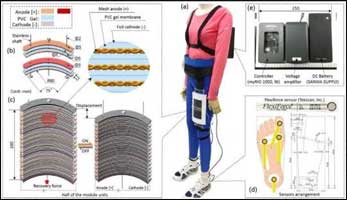- Home
- Editorial
- News
- Practice Guidelines
- Anesthesiology Guidelines
- Cancer Guidelines
- Cardiac Sciences Guidelines
- Critical Care Guidelines
- Dentistry Guidelines
- Dermatology Guidelines
- Diabetes and Endo Guidelines
- Diagnostics Guidelines
- ENT Guidelines
- Featured Practice Guidelines
- Gastroenterology Guidelines
- Geriatrics Guidelines
- Medicine Guidelines
- Nephrology Guidelines
- Neurosciences Guidelines
- Obs and Gynae Guidelines
- Ophthalmology Guidelines
- Orthopaedics Guidelines
- Paediatrics Guidelines
- Psychiatry Guidelines
- Pulmonology Guidelines
- Radiology Guidelines
- Surgery Guidelines
- Urology Guidelines
Wearable muscles to help people walk again

Scientists are one step closer to artificial muscles. Orthotics have come a long way since their initial wood and strap designs, yet innovation lapsed when it came to compensating for muscle power -- until now.
A collaborative research team has designed a wearable robot to support a person's hip joint while walking. The team, led by Minoru Hashimoto, a professor of textile science and technology at Shinshu University in Japan, published the details of their prototype in Smart Materials and Structures, a journal published by the Institute of Physics.
"With a rapidly aging society, an increasing number of elderly people require care after suffering from stroke, and other-age related disabilities. Various technologies, devices, and robots are emerging to aid caretakers," wrote Hashimoto, noting that several technologies meant to assist a person with walking are often cumbersome to the user. "[In our] current study, [we] sought to develop a lightweight, soft, wearable assist wear for supporting activities of daily life for older people with weakened muscles and those with mobility issues."
The wearable system consists of plasticized polyvinyl chloride (PVC) gel, mesh electrodes, and applied voltage. The mesh electrodes sandwich the gel, and when voltage is applied, the gel flexes and contracts, like a muscle. It's a wearable actuator, the mechanism that causes movement.
"We thought that the electrical mechanical properties of the PVC gel could be used for robotic artificial muscles, so we started researching the PVC gel," said Hashimoto. "The ability to add voltage to PVC gel is especially attractive for high-speed movement, and the gel moves with high speed with just a few hundred volts."
In a preliminary evaluation, a stroke patient with some paralysis on one side of his body walked with and without the wearable system.
"We found that the assist wear enabled natural movement, increasing step length and decreasing muscular activity during straight line walking," wrote Hashimoto. The researchers also found that adjusting the charge could change the level of assistance the actuator provides.
The robotic system earned first place in demonstrations with their multilayer PVC gel artificial muscle at the "24th International Symposium on Smart Structures and Materials & Nondestructive Evaluation and Health Monitoring" for SPIE the international society for optics and photonics.
Next, the researchers plan to create a string actuator using the PVC gel, which could potentially lead to the development of fabric capable of providing more manageable external muscular support with ease.
Healthy AgingMinoru Hashimotopolyvinyl chloridePVC gelrobotic artificial musclesRoboticsRobotics ResearchShinshu UniversitySmart Materials and Structuresstroke
Source : Press ReleaseNext Story
NO DATA FOUND

Disclaimer: This site is primarily intended for healthcare professionals. Any content/information on this website does not replace the advice of medical and/or health professionals and should not be construed as medical/diagnostic advice/endorsement or prescription. Use of this site is subject to our terms of use, privacy policy, advertisement policy. © 2020 Minerva Medical Treatment Pvt Ltd